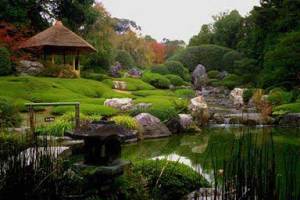A BRIEF INTRODUCTION TO JAPANESE GARDEN
As a student of garden design, I am introduced to many types of garden styles, from the very formal Italian garden, to the Renaissance French garden, to the informal natural style English garden. These are styles based on Europeans sensibility with the philosophy rooted in Christianity. The Japanese gardens, on the other hand, are rooted in eastern religious and philosophical ideas and therefore are quite different in principle.

History
The art of garden making was imported to Japan from Korea and China, perhaps in the six century AD, along with many other aspects of continental culture: writing, architecture, and urban planning to name but a few. Because of the ancient custom of using stones and ponds for prayers, however, the ancient Japanese people must have found the new Chinese/Korean ideas very familiar. It is easy to believe that, while embracing these newly imported ideas, the early Japanese garden designers also maintained as an essential element of their garden design the ancient, animistic perception that natural objects, like stones and ponds, are not inanimate but shelter a spirit.


During the Heian period (794-1185), gardens were built within the urban residences of the aristocracy. There were several interesting aspects of the design of these gardens - the creation of paradisaical imagery, the use of geometry, and the interweaving of poetic images. Of the paradisaical images created in the gardens, the most prevalent was that of the Pure Land - the heaven presided over by Amida Buddha. This was recreated in the garden by building an island (which represented the Pure Land) in a pond (an image of the vast 'ocean' that separates profane mortals from heaven). An arched bridge connected the island to shore, implying the potential of salvation for all.
In the Muromachi period (1333-1568), a new form of garden developed in the Zen Buddhist temples and warrior residences, in which a rarefied garden was built into a relatively small courtyard, associated with a sitting room. These gardens are properly called kare-san-sui, which means dry-mountain-water, revealing the essence of the garden as a scenic image of mountains and water, created without the use of real water.
The Momoyama period (1568-1600) is a brief transitional time between the medieval era and the Edo period. It was during the Momoyama period that the rustic tea ceremony, known as wabi-cha, developed. A new form of garden developed at this time that acted as an entrance to the tea-house. This garden is not a garden in the terms we usually think. It is intended as a place of passage - a stage on which one performs the physical and spiritual preparations required before entering the tea-house. By passing through a series of subtly designed thresholds in the garden, one is caused to release the daily cares of the world and enter a state of mind consonant with the understated aesthetics of wabi-cha.

|
|
The modern time. As gardens around the world evolve, the traditional Japanese garden has become a popular style. By applying the modern twist on the traditional themes the modern Japanese garden has become a thing of great beauty combining history with modern style.
 |
|
|
Basic styles
There are three basic styles: The hill and pond; the flat gardens and; the tea gardens.
Hill and pond garden is the basic style brought over from China. A pond fronts a hill (or hills). The pond can be an actual pond or represented by raked gravel. This style always denotes a mountain area and usually uses plants indigenous to the mountains. Stroll gardens are always hill and pond.
The flat style garden stems from the use of open, flat spaces in front of temples and palaces for ceremonies. These are often done in the karesansui style. This is a very Zen style (good for contemplation) and is representative of a seashore area (using the appropriate plants) Courtyards are always flat style gardens.
The design of the tea garden is the only time that function overrides form. The Roji (dewy path) is the focus of the garden along with the water basin and the gates. This is the exception to the rule. Plantings should be simple to the point of sparse. Always strive for a rustic feeling.
Philosophy
In order to appreciate and understand the Japanese garden, the viewer should consider nature as a picture frame into which the garden, or the man- made work of art, is inserted. It is in this way the garden also helps the visitor understand his surroundings. Simplicity is a key tenet of Zen. Embracing the everyday, unadorned things in life is to embrace truth. The cleanliness of simple form is a repeated motif in Japanese art of gardening. Asymmetry is intrinsic to Buddhist thought. There is no perfection in the world; imbalance is what creates all movement and energy. The exact center is never occupied, not in gardens or paintings. The main purpose of a Japanese garden is to bring serenity and nature into our busied lives. They remind us of the natural landscape, but in fact they are carefully controlled by man. Ultimately, the purpose of a Japanese garden is to enhance the quality of our life.
WORKS CITED
Barty, Phillips. Garden Design: The essential reference guide for all aspects of gardening. Paragon Publishing, 2001
Henry, Koch. (Photo credits). University of Guelph’s Web Site. Retrieved November7, 2007
http://www.uoguelph.ca/arboretum/gardenNA/gardenJG.htm.
Kinsaku, Nakane. Kyoto Gardens. Hoikusha Publishing Co. Japan, 1965
Japanese Garden. The Helpful Gardener Website. Retrieved november7, 2007
http://www.helpfulgardener.com/japanese/2003/
Japanese Gardens. Google Images Search. Retrieved november7, 2007
http://google.ca/images?q=japanese+gardens...


No comments:
Post a Comment